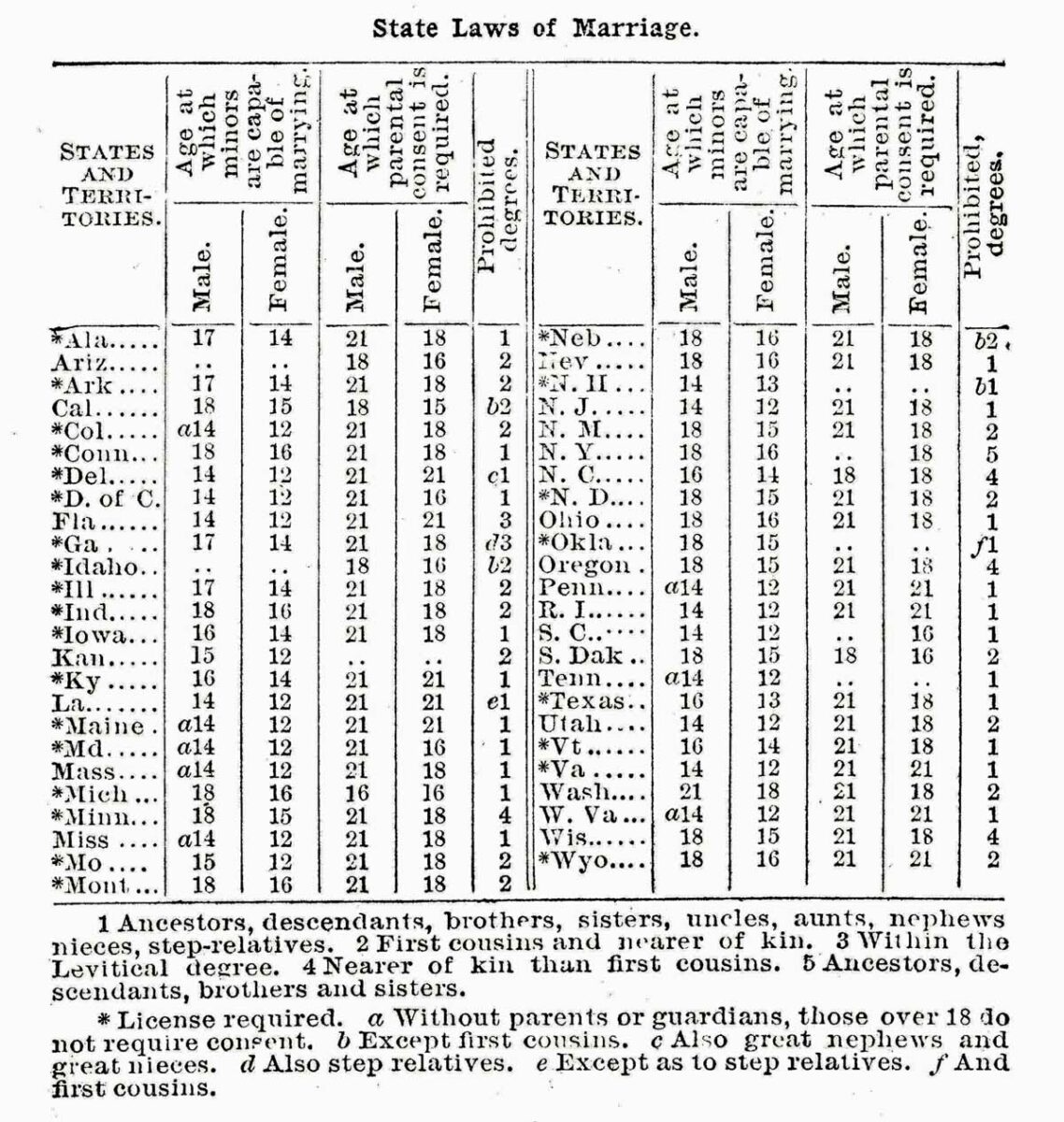We may receive a commission when you make a purchase from one of our links to sites such as eBay and others. As an Amazon Associate we earn from qualifying purchases. Thank you for support!
Today while going through my 1899 American Agriculturist Almanac, I came across a chart that shared the marriage laws by state in 1898. I thought this might be useful if you are researching your ancestry so am sharing it here as a reference in case you might need it.
Marriage records can often be confusing, and sometimes even incomplete, inaccurate, or missing altogether – but they are also a very valuable resource in tracking down your ancestors. Knowing the various laws and customs can also make it a lot easier for you to piece together the puzzle of your ancestry.
How to Read The Marriage Law Chart
While the chart is pretty much self-explanatory, I thought I would share a breakdown of what each column in the chart means as well as explain some other common rules and regulations regarding marriage in the United States in the late 1800’s.
Column One: The first column lists the state. An asterisk next to the state’s name indicates that a marriage license is required. Knowing that licensure is required can be a helpful clue in researching ancestry because it lets you know that there may be marriage records in some of the various archived databases that you can search for.
Column Two: Minium Age for Marriage: This column shows what the minimum age was for marriage in 1898. Some states had different requirements for males and females, so this column is further divided to show that difference.
Column Three: Parental Consent Required Age: This column shows at what ages parental consent was required for marriage, which is different from the minimum age of marriage.
Column Four: Prohibited Degrees of Marriage: This column uses abbreviations to indicate which things were allowed and not allowed for marriage in that state. The abbreviations are listed in the paragraphs below the table, but I’ll explain them a little more here as well.
Here is the chart for reference again:

1898 Marriage Laws and Prohibitions
The prohibited degrees by state are listed by abbreviation. These degrees basically say how closely two people getting married could be related. Here is a breakdown of these restrictions indicated by a number:
- Ancestors, descendants, brothers, sisters, uncles, aunts, nephews nieces, step-relatives.
- First cousins and nearer of kin.
- Within the Levitical degree.
- Nearer of kin than first cousins.
- Ancestors, descendants, brothers and sisters.
“Within the Levitical Degree” means the degrees of kinship where marriage is forbidden as per Leviticus 18 in the Bible.
In addition to these restrictions, there may have been other considerations or exceptions. Here are some others that are indicated by letter:
- a. Without parents or guardians, those over 18 do not require consent.
- b. Except first cousins.
- c. Also great nephews and great nieces.
- d. Also step relatives.
- e Except as to step relatives.
- f. And first cousins.
As you can see, there were quite a lot of differences between each of the states!
It wasn’t until around 1913 states began to adopt regulations requiring phsyical examinations to be married. Many states started requiring blood tests to check for Syphillis in the late 1930’s, though most states had abolished that requirement by the 1980’s, with Montana being the only one today which still requires testing for Rubella.
In addition to these rules, there were several other things to consider regarding marriage laws in the late 1800’s:
- Bigamous marriages were void and punishable. This means you could not legally be married to more than one person at a time. This law is still in place today.
- Marriage by force or fraud is punishable, and usually void on consent of injured party.
- Sound mind laws: According to our almanac, many states had laws against “marriage of paupers, idiots and insane persons.” Today many states still do require a waiting period as well as an affadavit stating each person is of sound mind.
- Miscegenation Laws: In about one-half of the states at this time, Marriages between two different races were also void or illegal. It wasn’t until 1967 that states were prohibited to restrict marriage between races.
Of course, it goes without saying, just because these laws existed doesn’t mean people actually followed them!
Our almanac also tells us a bit of other information about marriage laws internationally:
The tendency of the important foreign legislation of the last twenty years, especially in Germany, Switzerland, France, Australia and Japan, is asserted to tend towards an essentially common system of marriage and divorce law, and the same essential features characterize British and most American laws, though developed to a varying degree. German marriage law and the proposed family code of Japan are probably more distinctly than the others based on the conception of family rather than individual law.
From the 1899 American Agriculturist Almanac
If you are looking for information on the history of marriage or are trying to find some clues about your own ancestry, here are some other resources and references that might be helpful or interesting for you to explore:
While the 1898 Marriage Laws by State are all certainly outdated today, it is interesting to look at and think about and of course, if you are researching family history or ancestry during that time period it’s also very useful to know!
Have anything helpful to add or other resources for researching marriages in your family tree? I’d love to hear from you in the comments below!
